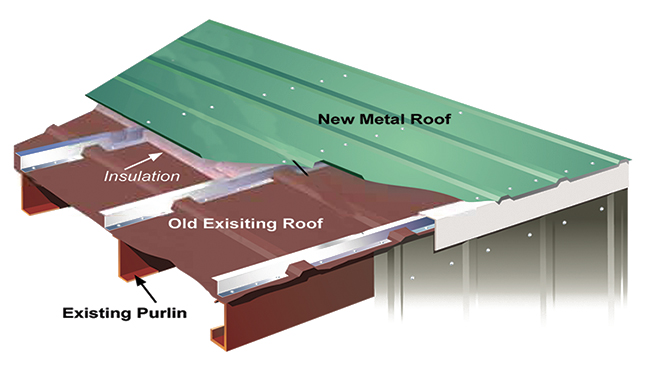Roofing is a critical aspect of any building, affecting both its functionality and aesthetics.
When it comes to low-slope roofs, one popular renovation method is metal panel roof retrofitting.
This process involves installing metal panels over the existing roof, offering a host of benefits. These include enhanced durability, energy efficiency, and cost savings over time.
In this guide, we delve into the intricacies of metal panel roof retrofitting, providing you with comprehensive insights to make informed decisions about your roofing renovation.

Understanding Metal Panel Roof Retrofitting
Metal panel roof retrofitting is a renovation method. It involves installing metal panels over an existing roof.
This technique is particularly suitable for low-slope or flat roofs. It provides a robust and weather-resistant surface.
The retrofitting process can be less disruptive and more cost-effective than a complete roof replacement. It also extends the lifespan of the existing roof.
By understanding the process and benefits of metal panel roof retrofitting, you can make an informed decision about your roof renovation project.
The Benefits of Retrofitting with Metal Panels
Retrofitting with metal panels offers several advantages. One of the main benefits is the durability of metal roofs.
Metal panels can withstand harsh weather conditions. They are resistant to wind, rain, and snow.
Another advantage is the energy efficiency of metal roofs. They reflect sunlight, reducing the need for air conditioning in hot weather.
Here are some additional benefits of metal panel roof retrofitting:
- Long lifespan
- Low maintenance
- Variety of aesthetic options
- Fire resistance
- Compatibility with solar panels
- Potential increase in property value
Key Considerations Before Retrofitting Your Roof
Before starting a retrofit project, a thorough inspection is crucial. This helps identify any existing roof damage.
The type of metal panel suitable for your climate and building requirements should be chosen carefully. For instance, corrugated panels might be a good fit for areas with heavy rainfall.
Working with experienced contractors specializing in metal roof retrofitting is also essential. They can ensure the project is executed correctly.
Lastly, consider the impact of the retrofit on the building’s structural load. The added weight of metal panels should be factored into the planning.
The Retrofitting Process: A Step-by-Step Guide
The process of retrofitting a metal panel roof over an existing roof involves several steps.
First, the existing roof is inspected and prepared. Any necessary repairs are made at this stage.
Next, insulation is installed. This is crucial for energy efficiency.
Then, the metal panels are installed. This should be done by experienced professionals.
Finally, the roof is sealed and finished. This includes installing proper drainage systems.
Here’s a simple breakdown of the process:
- Inspection and preparation
- Insulation installation
- Metal panel installation
- Sealing and finishing
”
Choosing the Right Metal Panels for Your Roof
Choosing the right metal panels for your roof is crucial. The type of panel can impact the roof’s performance and longevity.
Consider factors like the local climate and building requirements. For instance, corrugated panels might be suitable for areas with heavy rainfall.
Always consult with a roofing professional. They can guide you in making the best choice for your specific needs.
The Role of Insulation and Ventilation in Retrofitting
Insulation plays a key role in metal panel roof retrofitting. It helps maintain indoor temperature, reducing energy costs.
Ventilation is equally important. It prevents moisture buildup, which can lead to roof damage.
Incorporating both effectively can enhance the performance of your retrofitted roof. Always consult with a professional to ensure proper installation.
Cost Savings and Energy Efficiency
Retrofitting with metal panels can lead to significant cost savings. These savings come from reduced maintenance and lower energy bills.
Metal roofs reflect sunlight, reducing the need for air conditioning. This leads to lower energy consumption.
Over time, these savings can offset the initial cost of retrofitting. It’s a smart investment for the long term.
Conclusion: Maximizing the Value of Your Retrofit
Metal panel roof retrofitting is a wise choice for many property owners. It offers durability, energy efficiency, and cost savings.
Ready to upgrade your roof? Contact AJ Wells Roofing today at 904-553-0069 or visit our website to learn more about our metal roofing solutions.